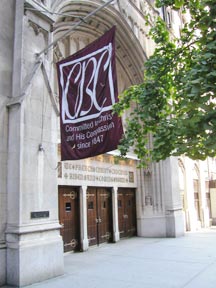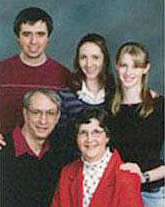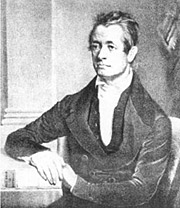The Spirit in Stone
Posted: 10/12/07
| The sanctuary of River Bend Church in Austin. (Photo by Tim Blonkvist) |
The Spirit in Stone
By Greg Warner
Associated Baptist Press
AUSTIN (ABP)—If your sanctuary could speak, what would it say? The truth is, it does speak—every day, some experts note.
Whether a towering neo-Gothic steeple that knifes the suburban sky or a one-room clapboard chapel nestled in the woods, every church structure carries a message to the watching world.
“It’s God’s calling card—it’s all he has,” said Texas architect Tim Blonkvist. “People are going to make an evaluation based on what they can see before they hear anything.”
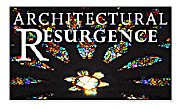 |
| See Related Articles: • The Spirit in Stone • Spirituality in architecture gets boost from revival of arts • Stained-glass windows tell stories of faith • Timeless grace: After 52 years, chapel continues to bless • Historic sanctuaries: To be or not to be? |
Whether they speak with bold clarity or subdued elegance, our church buildings are often the most prominent and persistent gospel message their non-Christian neighbors encounter.
“All architecture speaks, whether for better or worse,” said architect Larry Cook of Falls Church, Va., who has designed more than 200 church buildings during his 35-year career. “There are churches that definitely make a strong statement, and plenty of lousy ones too, and everything in-between.”
Almost everybody who commutes to work or school drives by one or a dozen churches every day. Those structures either grab the attention of passersby—and, like the Gothic cathedrals of old, perhaps steer their thoughts heavenward—or they blend into an increasingly nondescript urban landscape without a peep.
Christian architects like Blonkvist and Cook are passionate about their work with churches. But they are troubled by what many congregations have been building lately— “big box” churches that look like warehouses or office buildings, denominational cookie-cutter models, and prefabricated buildings built as fast and cheaply as possible.
“Church architecture today is not aesthetically pleasing,” Blonkvist said plainly. “Are you building something that is going to be an invitation and not a barrier? Is it beautiful and inspiring or ugly and economical?”
But after 300 years of mostly plain, utilitarian buildings—capped by three decades of what Cook calls megachurch “monster barns” devoid of Christian symbols—American Christians are poised for a revival in their church architecture. The architects say there is a hunger for spiritually expressive buildings that recapture a sense of sacred space, are rooted in a congregation’s specific location and lifestyle, use indigenous artwork and subtle symbolism, and are environmentally sensitive.
America’s church architecture has its roots among the Protestant reformers who came to America and built simple, functional buildings in reaction to the elaborate liturgy and iconography of European Catholicism.
 |
| River Bend Church, Austin. (Photo by Tim Blonkvist) |
“They believed you should divorce yourself from all those distractions,” said Michael Crosbie, editor of Faith and Form, a magazine about religious architecture. “There is a real sense of plainness in those buildings, but the people who worshipped in those buildings saw that as a way to focus on their Creator and as a way to get closer to their Creator.”
Although other immigrants brought more expressive architectural styles with them, pragmatism remained the dominant American architectural theme. Particularly as settlers carried their faith westward, function always trumped form.
“That’s a very American way,” said Crosbie of Essex, Conn., chair of architecture at the University of Hartford.
“There was the attitude: ‘All we need is shelter and the word of God,’” explained Blonkvist, who lives in San Antonio.
When there were clear architectural styles, they often came in the form of denominational templates, as each denomination tried to establish its own identity on the pluralistic American landscape.
Utilitarianism went into overdrive as megachurches emerged in the 1980s. Seeker-sensitive churches particularly favored secular architecture—borrowing from corporations, theaters and shopping malls—and stripped out all Christian symbols in an effort not to alienate non-Christians.
Several megachurches that wanted to build a “monster barn” for a sanctuary have turned down proposals by Cook’s firm.
“They didn’t really care what it looked like on the outside, only about how many people they could seat,” he said. “That’s not my type of architecture.”
“If that way works (at reaching non-Christians) I don’t see anything wrong with that at all,” added Cook, a Catholic. “You could have a great spiritual building on the inside.”
The Pennsylvania native noted the Amish people are great examples of practicing Christians, “but they haven’t got a single church that I know of. They worship in homes, schools and barns. … Yet somehow there is a spiritualism that exists in the people.”
Crosbie agreed contemporary churches “don’t look like churches and don’t feel like churches, but people find spirituality in all kinds of environments. You can have a spiritual aesthetic without a building. You can have a church in a field somewhere.”
Nonetheless, contemporary churches are “too secular” for many people who crave art and architecture that is more spiritually expressive, Crosbie said.
The architects agreed the tide is turning—both in the church and culture—toward more overt spiritual values, and the days of spiritually neutral churches may be ending.
“We have gone that direction, and people have become dissatisfied,” said Blonkvist, whose firm, Overland Partners of San Antonio, designed a Texas Baptist megachurch in Austin that typifies this new approach.
Riverbend Church has won numerous awards and been featured nationwide for its innovative architecture, which blends subtle religious symbolism into an architectural style called “regionalism.”
Build into a slope overlooking the Texas Hill Country, Riverbend’s $12 million facility was constructed from indigenous materials like local limestone and sandstone, giving it a permanent link to the land.
“We wanted to create the feeling that this was growing up out of the ground, not dropped down from the sky,” said Blonkvist, an Episcopalian.
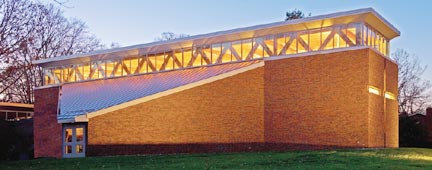 |
| Good Shepherd Episcopal Church in Silver Spring, Md. (Photo by Larry Cook) |
The sanctuary is a half circle, modeled after a Greek amphitheater, and the 2,500 seats follow the slope of the land, which is intended to recall the hillsides on which Jesus taught the crowds. Across the entire front of the sanctuary, behind the pulpit and platform, a massive window in the shape of a rainbow greets worshippers with a panoramic view of the countryside.
The window—symbolizing God’s promised hope—was the idea of former Pastor Gerald Mann, who opposed adorning the sanctuary with traditional Christian symbols and suggested: “Why can’t we just put what God put out there?”
The building’s other Christian symbols are likewise subtle. The exterior front, Blonkvist said, is framed by two towers symbolizing the crosses of the two thieves crucified with Jesus, a central terra cotta crown of thorns representing Jesus on the cross, and a row of twelve small windows.
But it doesn’t cost multiple millions to incorporate a spiritual aesthetic into church design and decor, architects say. Larry Cook’s firm designed Good Shepherd Episcopal Church in Silver Spring, Md. The 300-seat sanctuary, a modern variation on the cruciform design that uses clerestory windows to maximize natural light, was completed for $2.4 million—about average for a church project in the pricey Washington, D.C., area.
Even many smaller congregations that can afford only rented or renovated space are nonetheless determined to make that space an authentic expression of the congregation’s location, life and values.
They may be immigrant congregations or small emergent churches. They may gather in warehouses or storefronts. But the next generation of Christians, like every generation before them, will create their own architectural legacy, said Cook, whose father and son also are architects.
Artists and architects say that legacy likely will include a renewed interest in Christian symbolism and spirituality.
“I think that’s going to become more of a trend,” said Crosbie. “People are ready for that.”
In American culture, both sacred and secular, there is a new openness to aesthetic spirituality, said Judith Dupré, a writer and design consultant, whose oversized 2001 book, Churches, is am pictorial account of two millennia of religious architectural innovation—from the Pantheon and earliest Christian basilicas to the Gothic invasion and the gleaming American megachurch.
Christians have found that symbols, in art and architecture, “are doorways into a prayerful state for some people,” she said.
“People are becoming aware that the structures they enter every day do have an impact on their physical and spiritual well-being,” said Dupré, a Catholic and a student at Yale Divinity School. “Instead of the stripped-down model (of architecture), people reconsidering the power of symbols, and are selectively including them. That said, there is more awareness of the abstract expression of the gospel message.”
That message can be expressed not only in historic Christian symbols but in more subtle ways—the use of light, the way architectural lines steer the eye, the quality and fineness of the furnishings, and the carving on the front door, she said.
“All these things convey very subtly to the human being that we are entering a different place, a sacred space, that is different from any place else in their lives,” said Dupré, who lives outside of New York City.
The architects said the congregations that seek their services increasingly are interested in cultivating the spiritual message of their buildings.
“It’s almost an architect’s dream client,” said Crosbie. “Most architects are trained to be sensitive to what architecture and art can add to people’s lives.” However, he added, “A lot of architects are let down when they feel that their clients are not interested in those things, that they’re too focused on function and the utilitarian side of building.”
 |
| Gothic style cathedral of Our Lady of Chartres in France. (Photo licensed by Creative Commons) |
Americans are hungry for meaning and burned out on materialism, and that is affecting how and where they want to worship, Dupré said.
“I think that we are turning a very large corner in terms of our consumerist obsession,” she said. “We are exhausted of objects.”
Americans have been left numb by the “homogenization” of the cityscape, she said. With big-box retailers on every corner, surrounded by endless identical subdivisions, a new suburb in Scranton looks identical to one in Sacramento.
“There is a visual identity crisis happening in our country,” Dupré said. “People are looking to establish and develop a unique identity.”
They are getting some help from the architectural trend called regionalism that is helping communities cultivate architectural styles emphasizing the values and materials of their specific geographic area.
Regionalism rebels against the cookie-cutter homes and McMansions that dominate the American landscape. The new trend driving homebuyers “is the idea that their neighborhood should be unlike any other place,” Crosbie said. So many homebuyers now are looking into small towns and gentrified urban areas for “an authentic place to identify as their home.”
Creating buildings that are rooted in a certain place is a reaction to the culture’s prevailing sense of rootlessness, particularly for younger Americans, Crosbie said.
“The way they have experienced the world is more and more placeless,” he said.
In a world shrunk by television, cell phones, e-mail and instant international communication, many younger worshippers are drawn to smaller, more intimate congregations.
“It is a subconscious recognition that in their spiritual life they need a special place, different from any other place they experience in their week, and that mentally allows them to be spiritual,” he said.
The trend toward regionalism in church buildings, such as Riverbend and Good Shepherd churches, “is a spiritual expression” of that desire for rootedness, he added.
A companion trend to regionalism, the architects and artists said, is environmental sustainability. Increasingly, congregations want to build “green churches.” They are using local, natural and recyclable materials, and they’re becoming sensitive to energy consumption.
“People want to know there is a stewardship of God’s creation, so they want to design churches that are more sustainable,” said Douglas Hoffman, an architect from Cleveland, Ohio, who has been designing churches for 30 years. More sanctuary designs are using natural light, such as clerestory lighting, to save energy. And since light is also a Christian symbol, Hoffman said, “people will begin to appreciate that aesthetic.”
A few congregations are using renewable energy sources, such as wind and solar power, in an effort to build “carbon neutral” buildings. Sarah Hall, a stained-glass artist from Toronto, Ontario, is experimenting with “photovoltaic” glass in her creations.
Churches “need to take the lead” in sustainable construction, Dupré said. But so far, it is architects who have. Most have signed onto the U.S. Green Building Council’s LEED standards—Leadership in Energy and Environmental Design—a voluntary national benchmark for high-performance green buildings.
Cook said there was an effort in the 1970s to make churches environmentally conscious but it died out. Now it’s government buildings and schools leading the revolution.
Cook and the other architects are hoping Christians will step up to the plate and help create a new spiritual aesthetic for their buildings. Creating churches that are spiritually expressive, geographically indigenous and environmentally sustainable is no small task.
But the end result—as Blonkvist says, “something that is rich with symbolism, not overly adorned, and includes natural light and nature”—is worth the effort, even if only for an audience of one.
“It makes you feel proud to invite God into that worship space with you.”
To learn more, visit:
Judith Dupré www.judithdupre.com
Christians in the Visual Arts www.civa.org
Stained-glass artist Sarah Hall www.sarahhallstudio.com
Riverbend Church of Austin www.riverbend.com
